
To the Sierra, Again
This past Saturday on Labor Day weekend, I escaped the Valley’s summer heat — and learned a whole lot about history — by joining a small group on a trek into the Sierra.
A couple of months ago, I had taken a similar trip with some of these same folks. That time, we traveled to Kinsman Flat above North Fork.
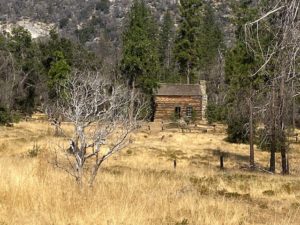 This time, our destination was the historic Ross Cabin above Kinsman Flat. Our tour guide was Connie Popelish of the North Fork History Group.
This time, our destination was the historic Ross Cabin above Kinsman Flat. Our tour guide was Connie Popelish of the North Fork History Group.
Connie is a retired archeologist from the Forest Service.
On this particular trip, she told us about Jesse Ross and the cabin he had built way back in the 1860’s. It likely is the oldest original structure still standing in Madera County.
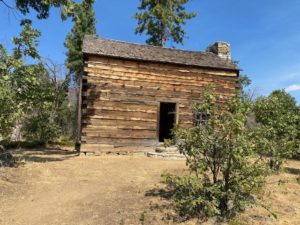 About three decades ago, the then-owners of the land where Jesse Ross had built his cabin were going to tear it down. But first, they offered it to the Forest Service. To be saved, the structure had to be moved elsewhere.
About three decades ago, the then-owners of the land where Jesse Ross had built his cabin were going to tear it down. But first, they offered it to the Forest Service. To be saved, the structure had to be moved elsewhere.
Connie went to work, getting a grant to preserve the cabin and convincing her bosses at the Forest Service that it was worth saving.
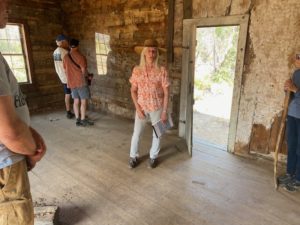 Then Connie and others decided that transporting that cabin in one piece was the best option, rather than tearing it apart and trying to reassemble it.
Then Connie and others decided that transporting that cabin in one piece was the best option, rather than tearing it apart and trying to reassemble it.
So in the summer of 1990, every piece of the cabin was numbered and labeled — just in case the move (by a commercial company) went bad and the structure fell apart while on the road to its new site. Then the cabin was jacked up, and big dollies with rubber tires were rolled underneath.
The cabin was towed about a half-mile to its new location, on Forest Service land near the Clearwater Fire Station. It stayed intact.
The following summer, volunteers from around the U.S. who had attended a class in log cabin stabilization went to work, replacing rotten logs with new ones that the volunteers cut by mostly using tools that would have been utilized when the cabin was first built.
Since that massive effort, the Ross Cabin has been open to the public — literally. There are no locks on gates to keep people out, and the cabin itself remains unlocked. 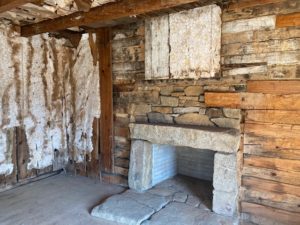
You walk into the 18-by-25 foot structure and see one big, open room. When Jesse Ross and his wife — a Native American woman named Mary Waspi — had their only child, Julia Belle, Ross divided the room to create bedrooms. He also cut into the ceiling to create an opening in the attic for another room in the one-and-1/2 story structure.
The room-dividing walls have been removed. Later owners tried to insulate the cabin, using newspapers — many from San Francisco.
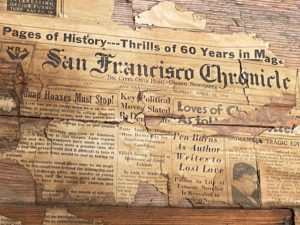 The cabin and land that surrounds it have been owned by several families since it was built. Ross had planted about five acres of apple trees. Those who later bought the cabin and land added more acres of trees — many of which are still productive.
The cabin and land that surrounds it have been owned by several families since it was built. Ross had planted about five acres of apple trees. Those who later bought the cabin and land added more acres of trees — many of which are still productive.
We saw those orchards from a distance. Then our group stopped for lunch at a small man-made lake on Ross Creek. The day was warm but not uncomfortable, and the surroundings were idyllic.
While the Jesse Ross cabin still exists in almost the same form that it did 160 years ago, the land surrounding it has, perhaps inevitably, changed. And still more dramatic changes are in the works.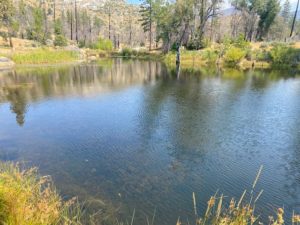
A developer has already built a small resort of sorts — including several glamping domes (similar to tents) on pads, along with a small hotel-style structure.
But much more aggressive development is on the way at the former Ross Ranch land. Resort owners plan to install about three-dozen prefab A-frames, build an events center and a restaurant, and more.
The idea is to attract city dwellers from the Valley, San Francisco, Los Angeles and who-knows-where else — to make the trek up the winding road from North Fork and spend money to “get away from it all.”
The resort will get its water from nearby Ross and Fish creeks, and dispose of waste through about a dozen septic tanks.
You might think there are questions about the water supply in the event of future droughts. And will those septic tanks be able to handle big crowds?
The resort representative who spent a bit of time with us this past Saturday said his company is working through all that. And, he said, the company respects history. By that, he meant at least part of the historic orchard will be kept, in some form or fashion.
He also said there would be some kind of marker set up around the presumed grave sites of Jesse Ross, his daughter and her husband. Those sites are near where the Ross cabin originally stood — not where it’s been moved.
The Ross cabin will remain as it is, because it’s on Forest Service land.
Not so, the private land it used to be on.
Call what’s about to happen what you like — progress, the loss of something historic — or something else.
Whatever you call it — it’s coming to the Sierra above North Fork.
